Investigation of the Time-Dependent Stability of a Coal Roadway under the Deep High-Stress Condition Based on the Cvisc Creep Model
Abstract
:1. Introduction
2. Analysis of Engineering Situations
2.1. Engineering Geology
2.2. Support Parameters and Solutions
- The roof support adopts six left-hand-threaded steel longitudinal bolts; the specification is φ 22 mm × L 2400 mm; and the row and column spacing is 1000 mm × 1000 mm, adopting an arch-shaped high-strength tray, with a steel grade of no less than Q235 and a specification of 150 mm × 150 mm × 10 mm, with an arch height of not less than 34 mm, equipped with self-aligning ball pads and drag-reducing nylon washers.
- The sidewall support adopts five bolts, and the row and column spacing is 850 mm × 1000 mm, and its parameters are the same as for the roof. The sidewall has a 16# wire braided metal diamond mesh with a size of 5800 mm × 1100 mm.
- The floor is supported by two bolts, and each bolt is fitted with two resin cartridges MSSK2350 and MSK2350. The pretension force is not less than 300 N·m.
3. Laboratory Experiments
3.1. Determination of Long-Term Strength of Coal and Rock
- By creep test. In this method, the long-term strength of rock is determined by creep experiments, which are roughly equivalent to the softening critical load.
- By empirical formula. The calculation formula readswhere Rc—rock uniaxial compressive strength, MPa; K—experience coefficient: expansive soft rock, K = 0.3~0.5; high-stress soft rock, K = 0.5~0.7; jointed soft rock, K = 0.4~0.8.σcs = K·Rc
3.2. Mineral Composition and Microstructure of Deep Surrounding Rocks
4. Cvisc Creep Numerical Simulation
4.1. Elasto-Viscoplastic Creep Constitutive Model
4.2. Numerical Model Description
4.3. Analysis of Plastic Zone
4.3.1. The Volume Variation of Shear-n Zone
4.3.2. The Volume Variation of Tension-n Zones
4.3.3. The Volume Variation of Tension-p and Shear-p Zones
4.4. Analysis of Damage Variables
4.5. Analysis of the Displacement Field
5. Engineering Applications
5.1. Measuring Point Arrangement
5.2. Model Validation by Engineering Practice
6. Conclusions
- The long-term strength of coal is lower than that of sandy mudstone. The long-term strength of the sandy mudstone and coal is 39.95 MPa and 18.65 MPa, respectively. The creep deformation of coal is more obvious than that of sandy mudstone.
- Under the high-stress environment in deep coal mines, creep has a significant influence on the deformation of coal and rock. Under bare roadway conditions, the creep composed 45~88% of the deformation, and the damage caused was 17.5%.
- After roadway excavation, the creep of the surrounding rock can be divided into three stages: the acceleration stage (0~60 d), the decaying stage (60~360 d), and the stable stage (360~720 d). In the acceleration stage, the displacement and damage of the surrounding rock increase rapidly; in the decaying stage, the displacement of surrounding rock and the damage increase slowly; in the stable stage, the displacement slowly increases and the damage decreases.
- Bolting and shotcrete can effectively suppress the displacement and damage of the surrounding rock. Bolting and shotcrete closed the surrounding rock and maintained the residual strength of the surrounding rock. The support and the surrounding rock together acted as the load-bearing structure; this increased the stress threshold of the surrounding rock rheology and increased the stability of the roadway. In terms of restraining the creep displacement of the surrounding rock, there was no difference between the straight anchor and the oblique anchor. In terms of restraining the shear plastic zone, the oblique anchor had an advantage, and the straight had an advantage in suppressing the tensile plastic zone.
- Enhancing the density of the anchor rod support strengthens the surrounding rock in weak areas of the roadway. Strengthening the support provides greater lateral confining pressure to the surrounding rock, effectively improving the long-term strength of the creep zone of the surrounding rock.
- The research results reveal the creep characteristics of soft rock under deep high-stress conditions, providing a reference for the study of the long-term stability of coal and rock masses under high-stress conditions. At the same time, it also reminds mining workers to pay attention to the impact of time on mining. (Table 7).
Author Contributions
Funding
Informed Consent Statement
Data Availability Statement
Acknowledgments
Conflicts of Interest
References
- Helal, H.; Homand-Etienne, F.; Josien, J.P. Validity of uniaxial compression tests for indirect determination of long-term strength of rocks. Int. J. Min. Geol. Eng. 1988, 6, 249–257. [Google Scholar] [CrossRef]
- Lajtai, E.Z. Time-dependent behavior of the rock mass. Geotech. Geol. Eng. 1991, 9, 109–124. [Google Scholar] [CrossRef]
- Chen, Z.Q.; He, C.; Dong, W.J.; Ma, G.Y.; Pan, X.Y.; Pei, C.Y. Comparative analysis of physical and mechanical properties and study on energy damage evolution mechanism of Jurassic and Cretaceous muddy sandstones in northern Xinjiang. Geotech. Mech. 2018, 39, 1–13. [Google Scholar]
- Liu, X.X.; Li, S.N.; Zhou, Y.M.; Li, Y.; Wang, W.W. Study on creep characteristics and long-term strength of high-stress argillaceous siltstone. J. Rock Mech. Eng. 2020, 39, 138–146. [Google Scholar]
- Ma, Q.Y.; Yu, P.Y.; Yuan, P. Experimental study on the influence of dry wet cycle on the creep characteristics of deep siltstone. J. Rock Mech. Eng. 2018, 37, 593–600. [Google Scholar]
- Yao, Q.L.; Zhu, L.; Huang, Q.X.; Yang, P.; Xu, Z. Experimental study on the influence of water content on the creep characteristics of fine-grained feldspar lithic sandstone. J. Min. Saf. Eng. 2019, 36, 1034–1042. [Google Scholar]
- Li, G.Y. Experimental study on the influence of water on the creep mechanical properties of coal and rock. Master’s Thesis, Xi’an University of Science and Technology, Xi’an, China, 2017. [Google Scholar]
- Liu, Y.K. Research on the Damage Evolution and Rheological Characteristics of Deep Rock Mass under the Action of Water and Rock. Ph.D. Thesis, Central South University, Changsha, China, 2012. [Google Scholar]
- Zhang, Q.Y.; Zhang, L.Y.; Xiang, W.; Jiang, L.Y.; Ding, Y.Z. Study on triaxial creep test of gneissic granite considering temperature effect. Geotech. Mech. 2017, 38, 2507–2514. [Google Scholar]
- Chen, G.Q.; Guo, F.; Wang, J.C.; Zhou, Y.X. Experimental study on triaxial creep properties of quartz sandstone after freezing and thawing. Geotech. Mech. 2017, 38, 203–210. [Google Scholar]
- Wang, Y.C.; Wang, Y.Y.; Li, J.G. Research on the creep mechanism of shale under chemical corrosion effect. Coal Mine Saf. 2019, 50, 67–71. [Google Scholar]
- Jiang, Z.B. Experimental Study on Creep Characteristics of Rocks under Multiple Environmental Effects and Mechanical Models. Ph.D. Thesis, Dalian Maritime University, Dalian, China, 2016. [Google Scholar]
- Shen, Z.; Wang, J.; Ning, J.G. Study on the creep characteristics of filling materials considering the content of cement. Min. Res. Dev. 2021, 41, 57–65. [Google Scholar]
- Zhao, B.Y.; Liu, D.Y.; Zhu, K.S.; Zheng, Z.M.; Xue, K.X. Experimental study on uniaxial direct tensile creep characteristics of Chongqing red sandstone. J. Rock Mech. Eng. 2011, 30, 3960–3965. [Google Scholar]
- Hu, B.; Wang, Z.L.; Liang, B.; Li, G.; Wang, J.G.; Chen, G. Experimental study on creep characteristics of rocks. Exp. Mech. 2015, 30, 438–446. [Google Scholar]
- Li, P. Experimental study on acoustic emission under the coupling effect of coal rock seepage and creep. Min. Saf. Environ. Prot. 2017, 44, 19–23. [Google Scholar]
- Gong, H.; Li, C.H.; Zhao, K. The b-value characteristics of short-term creep sound emission in red sandstone. J. Coal Sci. 2015, 40, 85–92. [Google Scholar]
- Niroshan, N.; Yin, L.; Sivakugan, N.; Veenstrs, R.L. Relevance of SEM to Long-Term Mechanical Properties of Cemented Paste Backfill. Geotech. Geol. Eng. 2018, 36, 2171–2187. [Google Scholar] [CrossRef]
- Liu, C.X.; Wang, L.; Zhang, X.L.; Li, M.T.; Zhou, T. Microscopic damage mechanism analysis of short-term creep tests of deep well coal and rock under different confining pressures. Geotech. Mech. 2017, 38, 2583–2588. [Google Scholar]
- Jiang, D.Y.; He, Y.; Ouyang, Z.H.; Pan, P.Z.; Wang, X.S.; Xie, K.N.; Jiang, X. Statistical analysis of acoustic emission energy and cross-sectional morphology of sandstone under uniaxial creep. J. Coal Sci. 2017, 42, 1436–1442. [Google Scholar]
- Xu, P.; Yang, S.Q. Numerical simulation of creep mechanical properties of composite rock under triaxial compression. J. Min. Saf. Eng. 2018, 35, 179–187. [Google Scholar]
- Yin, G.Z.; He, B.; Wang, H.; Zhang, X.M. Creep damage and failure law of overlying rock under the influence of deep mining. J. Coal Sci. 2015, 40, 1390–1395. [Google Scholar]
- Li, L.C.; Xu, T.; Tang, C.A.; Zhu, L.K. Numerical simulation of rock creep instability and failure process under uniaxial compression. Geotech. Mech. 2007, 28, 1978–1983. [Google Scholar]
- Lu, Y.L.; Wang, L.G. Numerical simulation of rock creep damage and fracture process based on microcrack evolution. J. Coal Sci. 2015, 40, 1276–1283. [Google Scholar]
- Cai, M.F. Rock Mechanics and Engineering, 2nd ed.; Science Press: Beijing, China, 2013. [Google Scholar]
- Shen, M.R.; Chen, J.F. Rock Mechanics; Tongji University Press: Shanghai, China, 2006. [Google Scholar]
- Zuo, Y.Y.; Han, L.; Hu, H.; Luo, S.Y.; Zhang, Y.; Cheng, X.M. Visco-elastic–Plastic Creep Constitutive Relation of Tunnels in Soft Schist. Geotech. Geol. Eng. 2018, 36, 389–400. [Google Scholar] [CrossRef]
- Liu, K.Y.; Xue, Y.T.; Zhou, H. A Nonlinear Viscoelastic-plastic Creep Model for Soft Rock with Unsteady Parameters. J. China Univ. Min. Technol. 2018, 47, 921–928. [Google Scholar]
- Zhang, S.C.; Sheng, D.F.; An, W.J.; Liu, B.J.; Qi, R.Q.; Cheng, J.X. Nonlinear viscoelastic plastic analysis of rubber asphalt composite materials based on improved Burgers model. Mech. Q. 2021, 42, 528–537. [Google Scholar]
- Guo, H.; Liu, Y.; Cui, B.Q.; Li, H.; Guo, Y.L. Research on creep damage model of filling paste. Min. R & D 2018, 38, 104–108. [Google Scholar]
- Yin, Z.P.; Liu, X.F.; Zhang, J.N. A Nonlinear Creep Damage Model for Aqueous Rock Mass and Its Application. J. Appl. Mech. 2017, 34, 377–383. [Google Scholar]
- Cai, Y.; Cao, P. A non-stationary rock creep model considering damage based on the Burgers model. Geotech. Mech. 2016, 37, 369–374. [Google Scholar]
- Wang, Y.Y.; Sheng, D.F. Research on the entire process of rock creep considering damage based on the Burgers model. Mech. Q. 2019, 40, 143–148. [Google Scholar]
- Huang, H.F.; Ju, N.P.; Huang, M.; Zhang, C.Q.; Zhu, J.L. A Nonlinear Creep Damage Model for Soft Rock and Its Experimental Study Hydrology. Geol. Eng. Geol. 2017, 44, 49–54. [Google Scholar]
- Zhao, Y.L.; Ma, W.H.; Tang, J.Z.; Yuan, C.; Li, S.Q.; Wan, W. A rock variable parameter creep damage model based on plastic expansion and its engineering application. J. Coal 2016, 41, 2951–2959. [Google Scholar]
- Song, Y.J.; Lei, S.Y.; Liu, X.K. A Nonlinear Creep Model of Rock Based on Hardening and Damage Effects. J. Coal Sci. 2012, 37, 287–292. [Google Scholar]
- Cheng, A.P.; Fu, Z.X.; Liu, L.S.; Dai, S.Y.; Huang, S.B.; Ye, Z.Y. Creep Hardening Damage Characteristics and Nonlinear Constitutive Model of Cemented Fill. J. Min. Saf. Eng. 2022, 39, 449–457. [Google Scholar]
- Kang, H.P.; Fan, M.J.; Gao, F.Q.; Zhang, H. Deformation Characteristics and Support Technology of Surrounding Rocks in Deep Well Tunnels Exceeding Kilometers. J. Rock Mech. Eng. 2015, 34, 2227–2241. [Google Scholar]
- Huang, W.P.; Li, C.; Xing, W.B.; Yuan, Q.; Qu, G.L. The long term asymmetric large deformation mechanism and control technology of kilometer-deep roadway under creep state. J. Min. Saf. Eng. 2018, 35, 481–489. [Google Scholar]
- Jiang, F.X.; Feng, Y.; Kouame, K.J.A.; Wang, J.C. Study on the “creep type” impact mechanism of high ground stress extra-thick coal seam. J. Geotech. Eng. 2015, 37, 24–30. [Google Scholar]
- Wang, G.G.; Zhu, S.T.; Jiang, F.X.; Wang, B.Q.; Zhou, T.; Zuo, E.N.; Kong, Z. Research on the mechanism and prevention of overall instability and impact of isolated coal bodies in kilometer-deep mine tunnels. J. Min. Saf. Eng. 2019, 36, 968–976. [Google Scholar]
- Song, Y.F.; Pan, Y.S.; Li, Z.H.; Yin, W.L. Research on the creep instability of isolated coal pillars under rockburst. Coal Mine Saf. 2018, 49, 47–50. [Google Scholar]
- Chen, G.X.; Guo, B.B.; Hao, Z. The starting conditions of rock burst under the influence of accelerated creep in the surrounding rock of circular tunnels. J. Coal Sci. 2020, 45, 3401–3407. [Google Scholar]
- Yang, Y.J.; Xing, L.Y.; Zhang, Y.Q.; Ma, D.P. Study on the long-term stability of gypsum pillar based on creep test. J. Rock Mech. Eng. 2015, 34, 2106–2113. [Google Scholar]
- Yang, Y.J.; Duan, H.Q.; Liu, C.X.; Hao, Y.R. Reasonable Setting of Uphill Protection Coal Pillars in Deep Well Mining Areas Considering Long-Term Stability. J. Min. Saf. Eng. 2017, 34, 921–927. [Google Scholar]
- Yang, Y.; Tian, R.D. Creep law of coal pillars left underground in coal mines. J. Liaoning Univ. Eng. Technol. Nat. Sci. Ed. 2016, 35, 1026–1031. [Google Scholar]
- Zhang, J.F.; Wang, K.; Zhang, X.Q.; Wei, G.S.; Wang, C. Numerical study on the width of residual coal pillars under the influence of creep failure. Min. Res. Dev. 2017, 37, 51–54. [Google Scholar]
- Pan, Y.S.; Zhu, P.; Wang, D.L. The creep simulation test and numerical analysis of deep tunnel floor heave and its prevention and control. J. Heilongjiang Inst. Min. Technol. 1998, 8, 1–7. [Google Scholar]
- Wei, S.J.; Gou, P.F.; Yu, C.S. Simulation and control technology of surrounding rock creep of large section broken chamber. J. Min. Saf. Eng. 2013, 30, 489–494. [Google Scholar]
- Dong, E.Y.; Wang, W.J.; Ma, N.J.; Yuan, C. Analysis and control technology of anchoring spatiotemporal effect considering surrounding rock creep. J. Coal Sci. 2018, 43, 1238–1248. [Google Scholar]
- Skrzypkowski, K.; Zagórski, K.; Zagórska, A.; Apel, D.B.; Wang, J.; Xu, H.; Guo, L. Choice of the Arch Yielding Support for the Preparatory Roadway Located near the Fault. Energies 2022, 15, 3774. [Google Scholar] [CrossRef]
- Wang, J.; Apel, D.B.; Xu, H.W.; Wei, C.; Skrzypkowski, K. Evaluation of the Effects of Yielding Rockbolts on Controlling Self-Initiated Strainbursts: A Numerical Study. Energies 2022, 15, 2574. [Google Scholar] [CrossRef]
- Zhang, C.; Bai, Q.S.; Han, P.H. A review of water rock interaction in underground coal mining: Problems and analysis. Bull Eng Geol Environ. 2023, 82, 157. [Google Scholar] [CrossRef]
- Han, P.H.; Zhang, C.; Ren, Z.P.; He, X.; Jia, S. The influence of advance speed on overburden movement characteristics in longwall coal mining: Insight from theoretical analysis and physical simulation. J. Geophys. Eng. 2021, 18, 163–176. [Google Scholar] [CrossRef]
- He, M.C.; Jing, H.H.; Sun, X.M. Soft Rock Engineering Mechanics; Science Press: Beijing, China, 2002; pp. 18–21. [Google Scholar]
- Hu, K.; Feng, Q.; Li, H.; Hu, Q. Study on creep characteristics and constitutive model for Thalam rock mass with a fracture in a tunnel. Geotech. Geol. Eng. 2018, 36, 827–834. [Google Scholar] [CrossRef]
- Liu, J.W.; Wang, Y.J.; Song, X.M. Numerical simulation of creep law of coal roadway supported by ultra-thousand deep wells. Min. Res. Dev. 2017, 37, 14–17. [Google Scholar]
- Jia, G.S.; Kang, L.J. Study on stability of coal pillars in mining roadway with fully mechanized caving mining. J. China Coal. Soc. 2002, 27, 6–10. [Google Scholar]
- Bai, J.B.; Hou, C.Z.; Huang, H.F. Numerical simulation of the stability of narrow coal pillars along goaf roadway. Chin. J. Rock. Mech. Eng. 2004, 23, 3475. [Google Scholar]
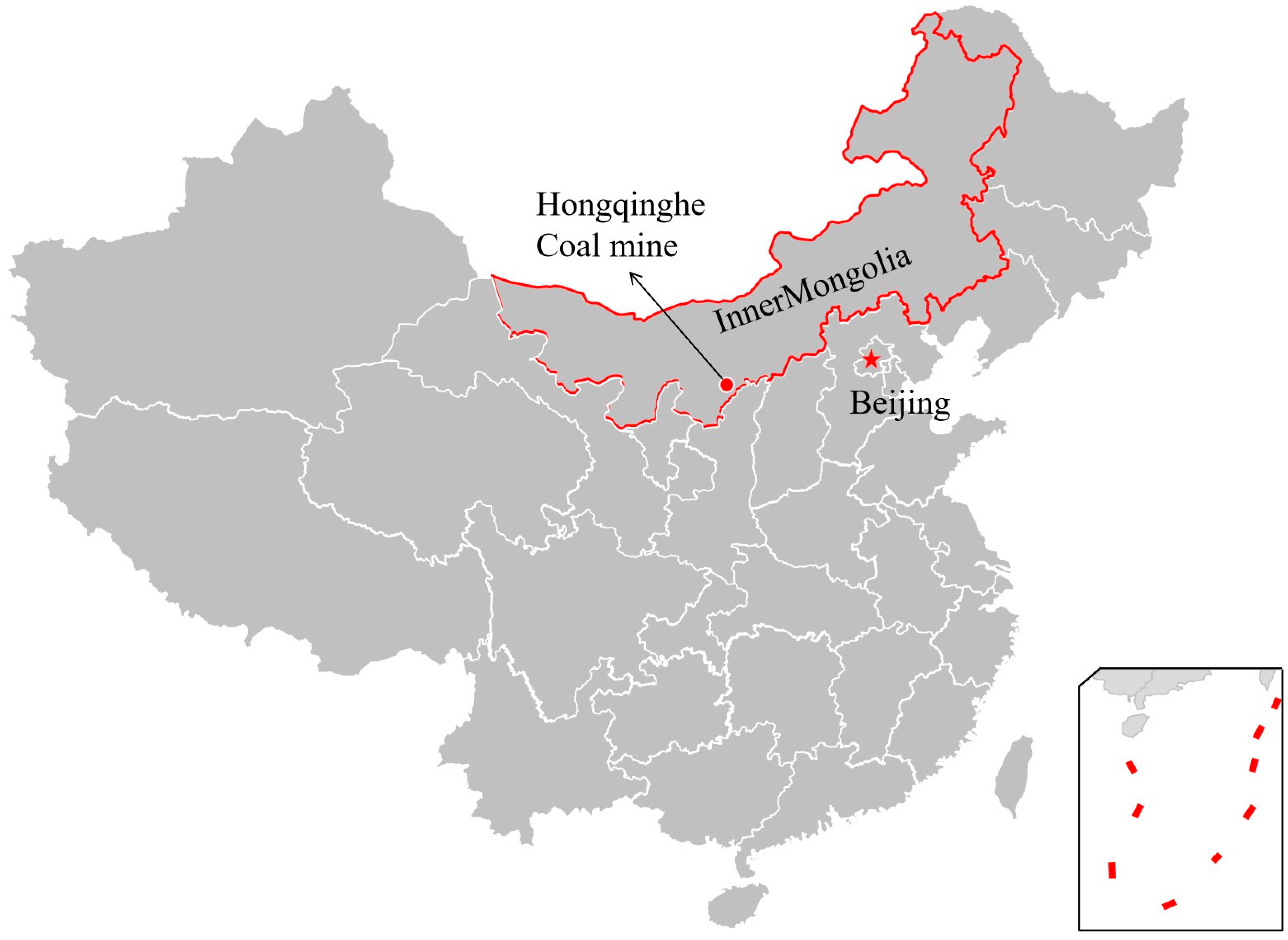
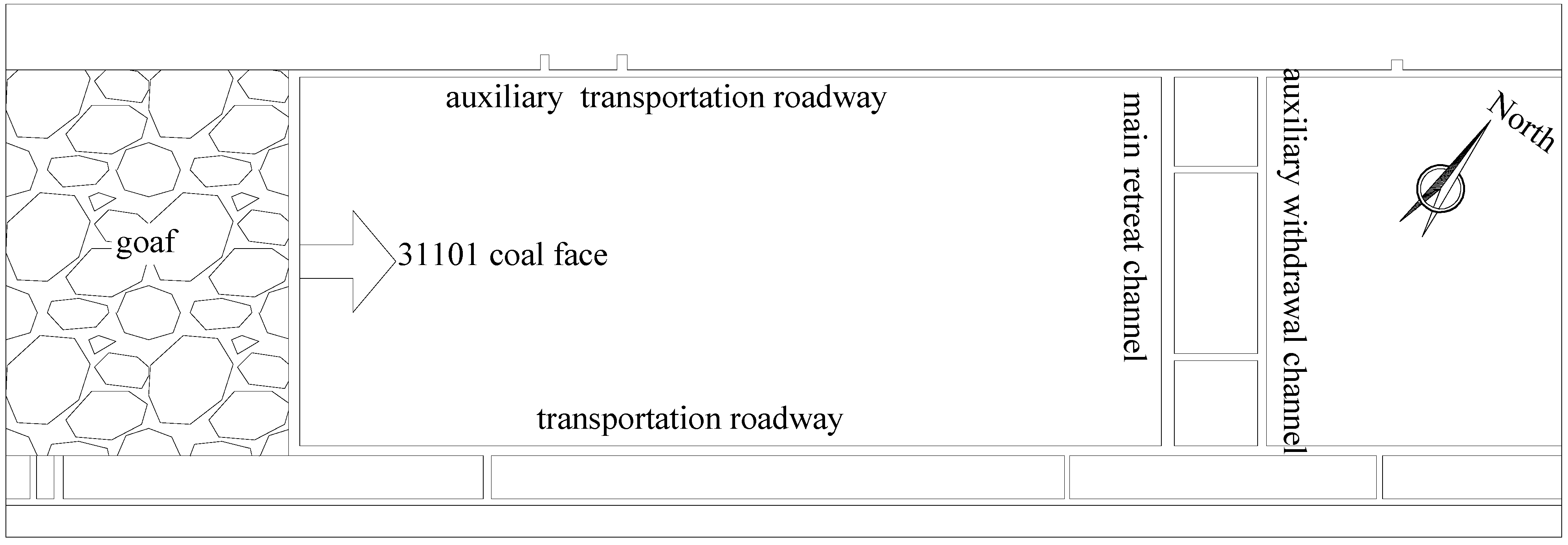


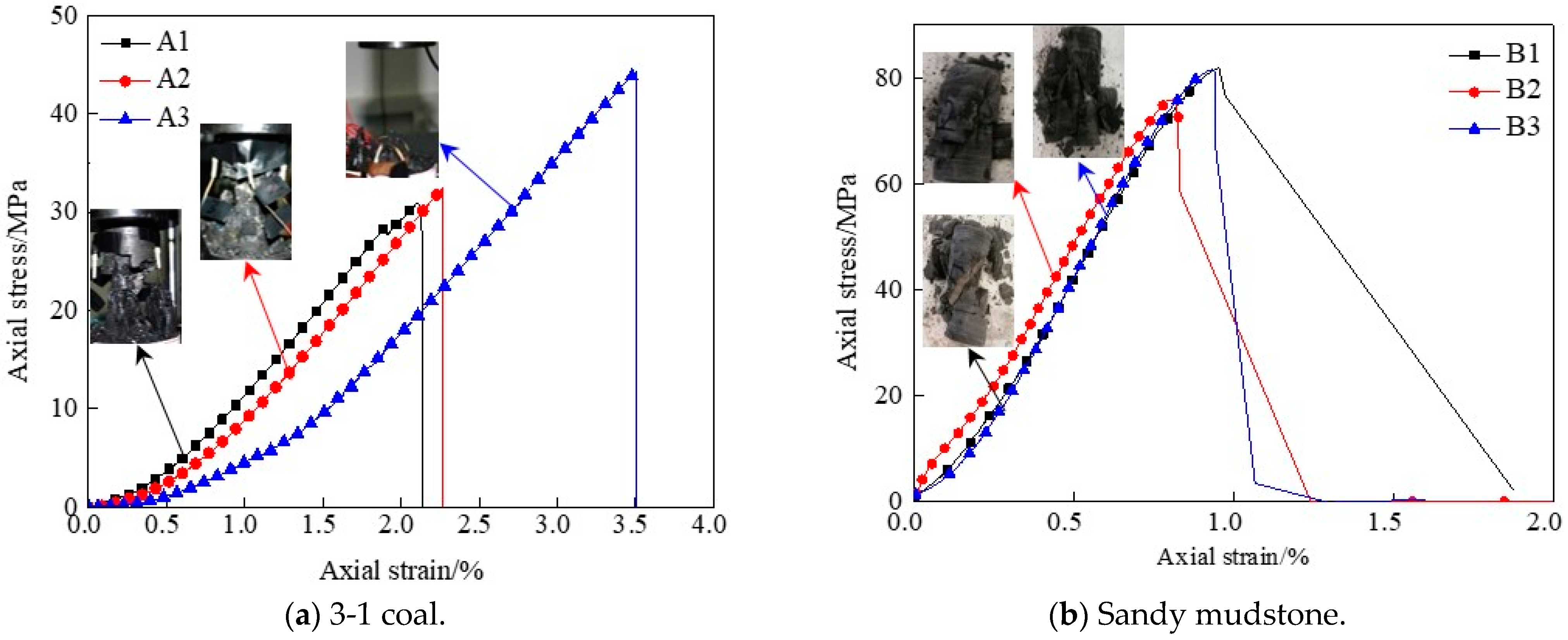
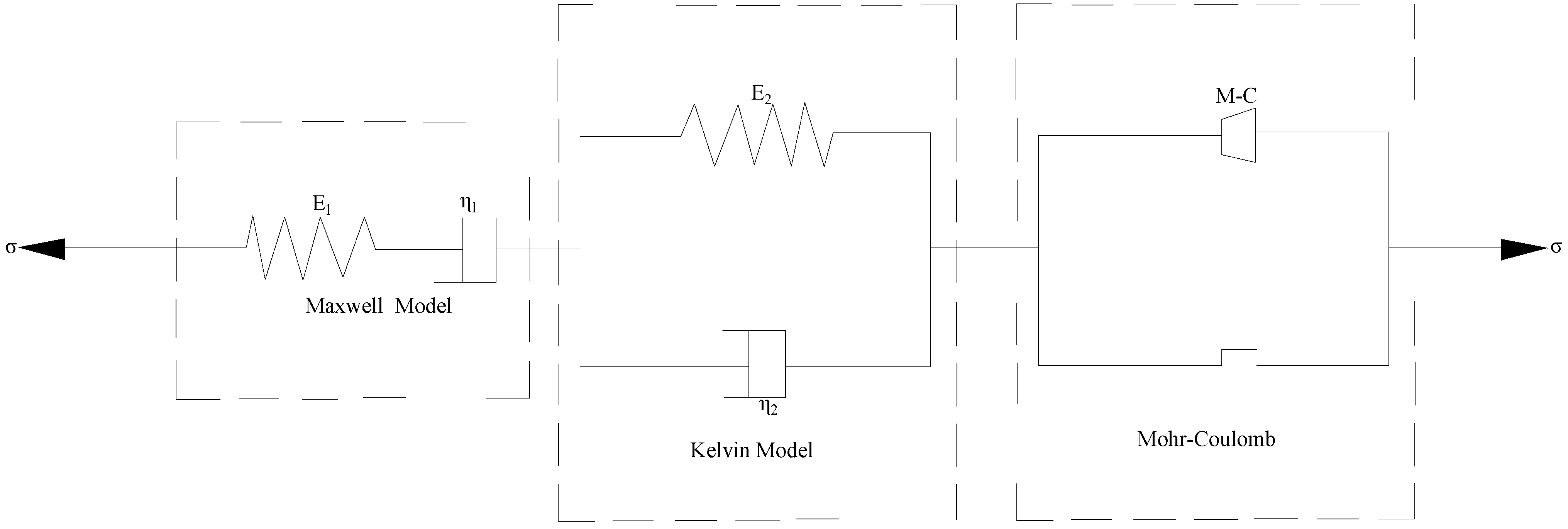

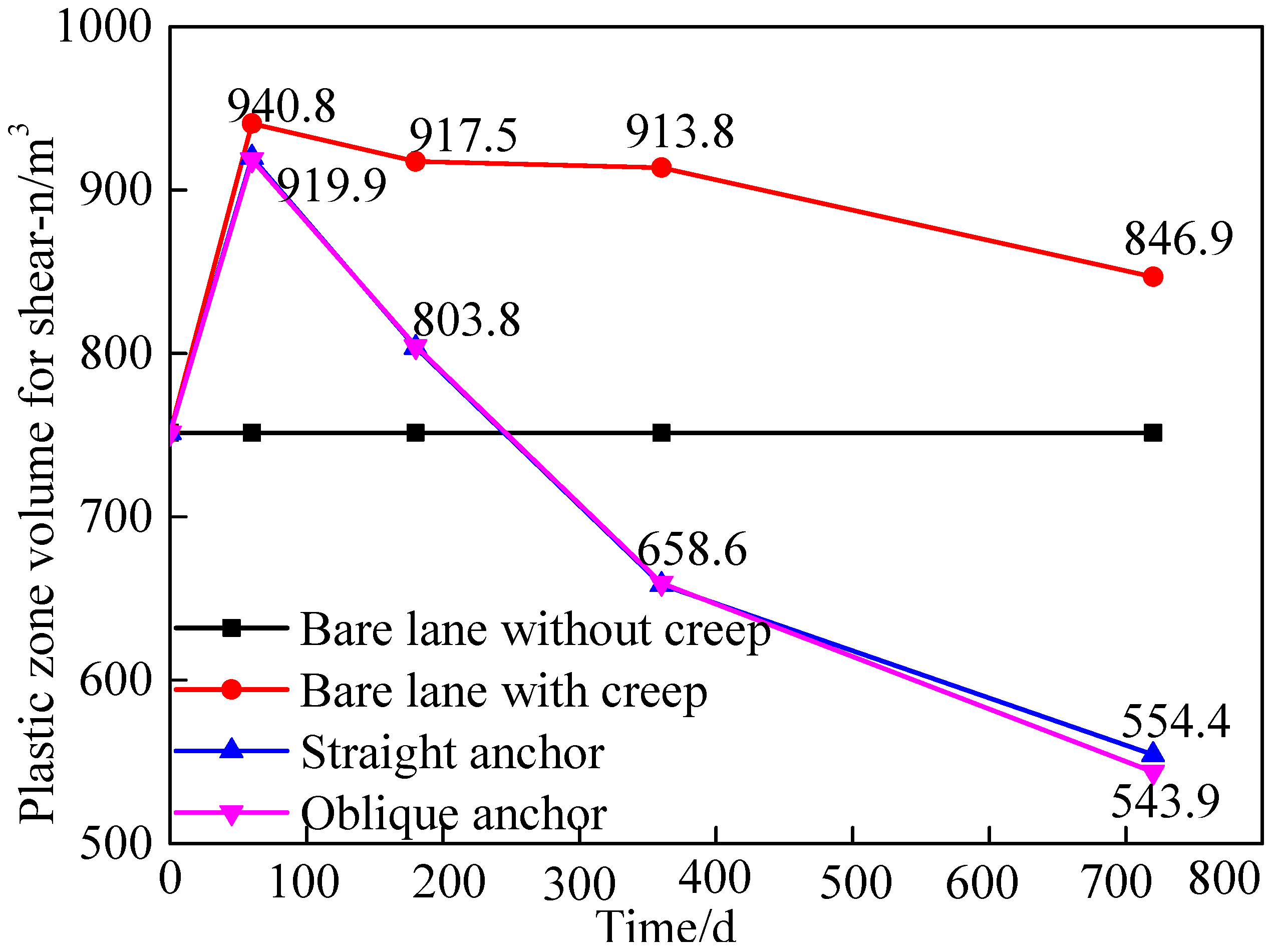
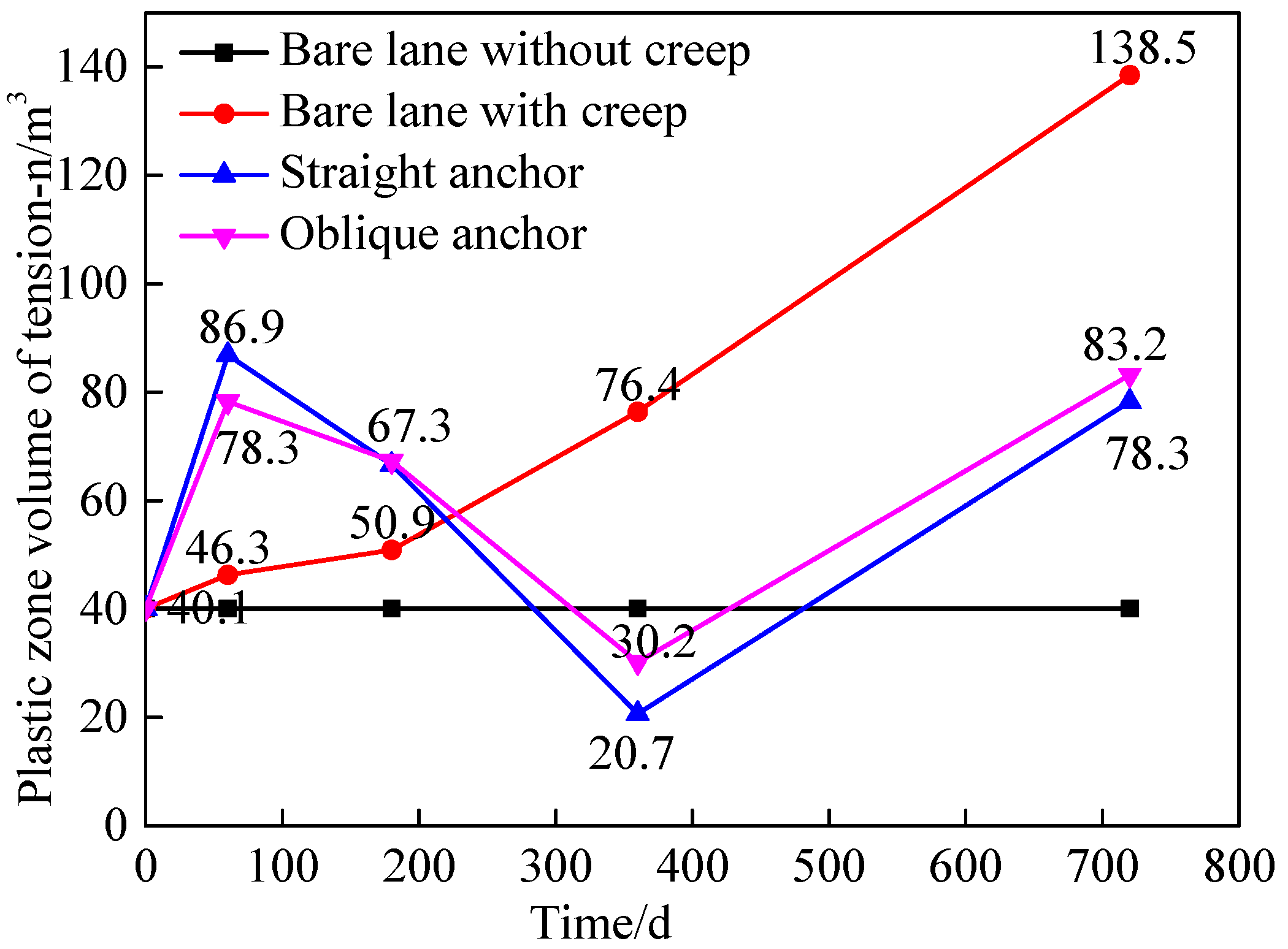

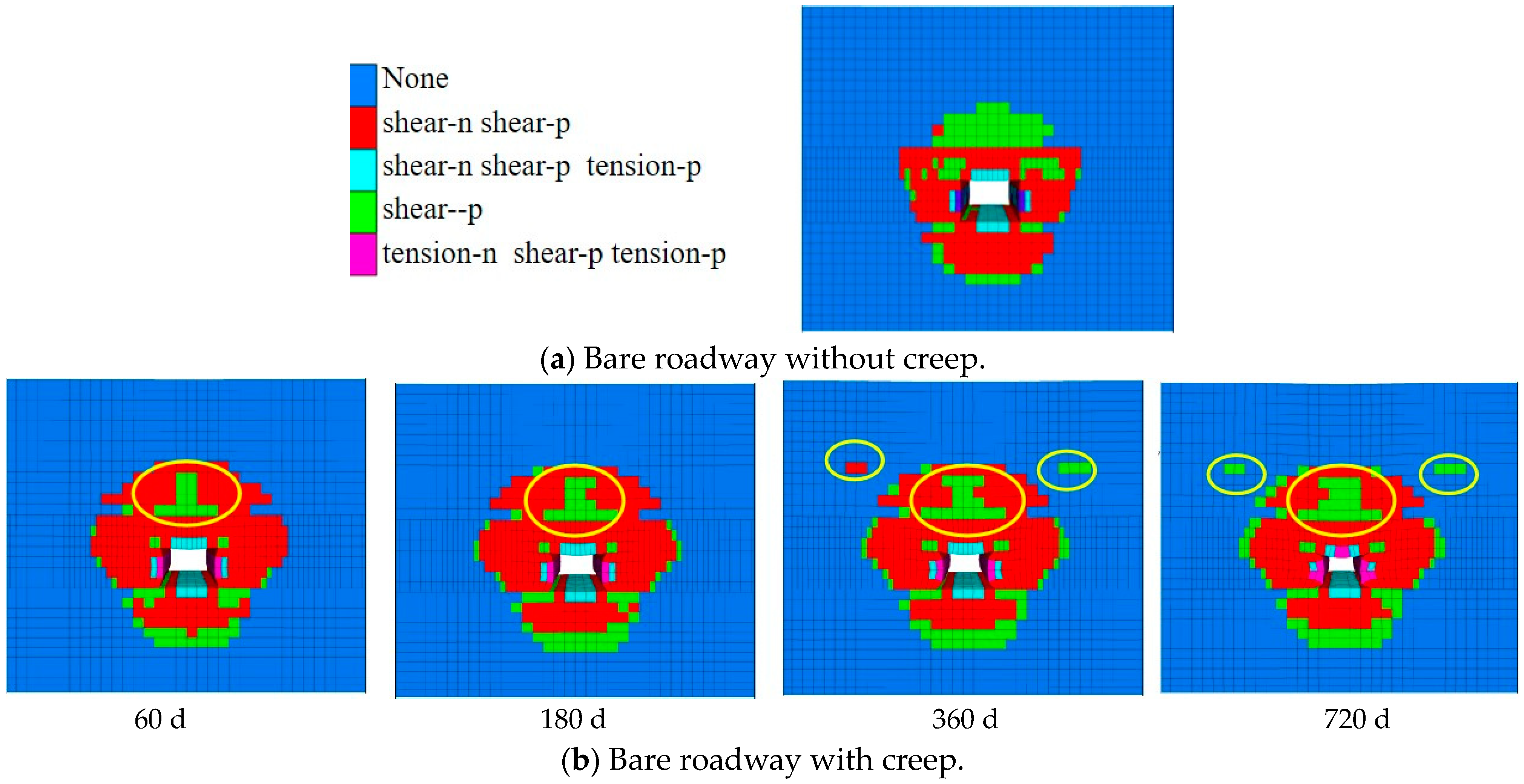
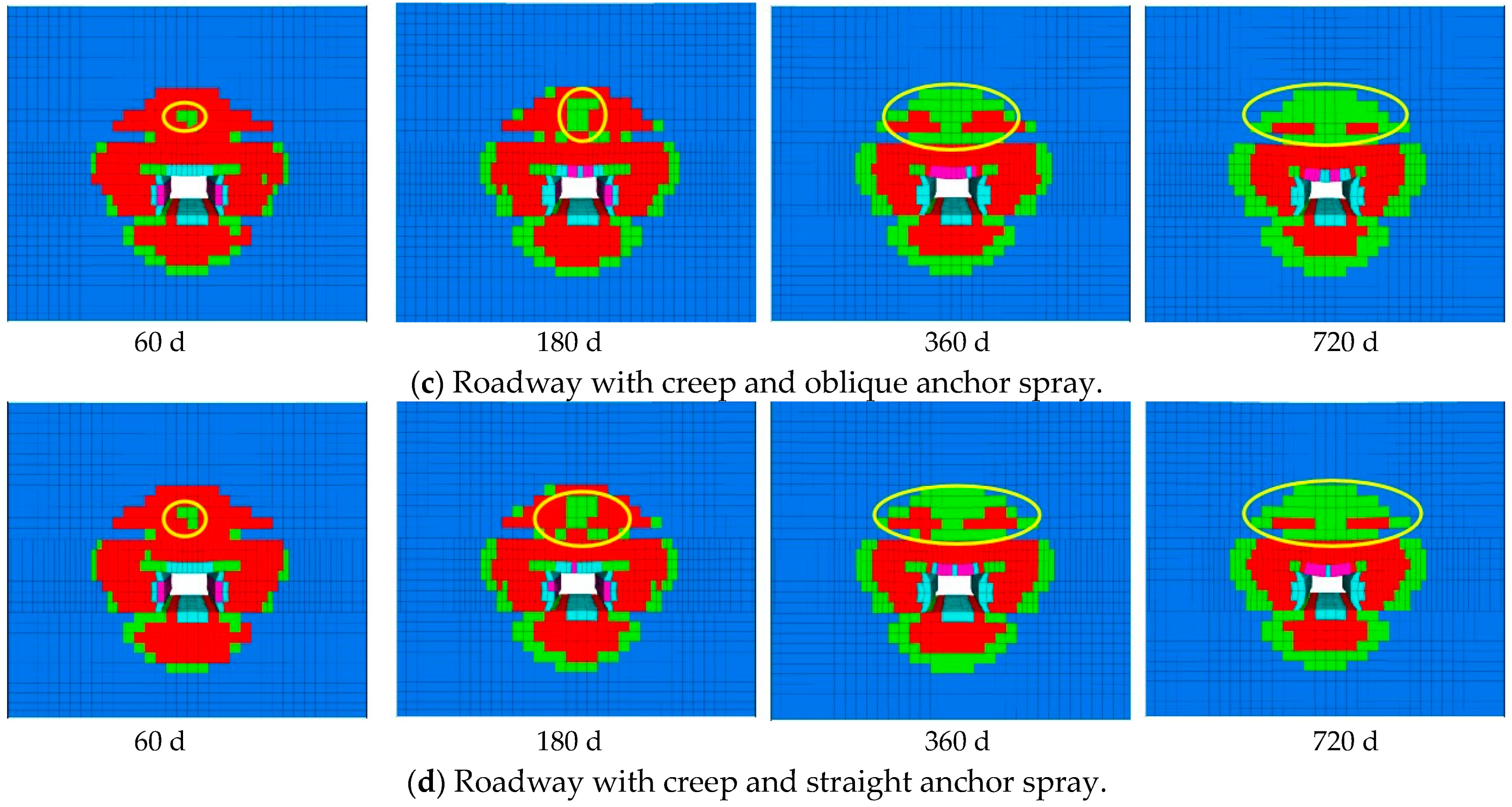

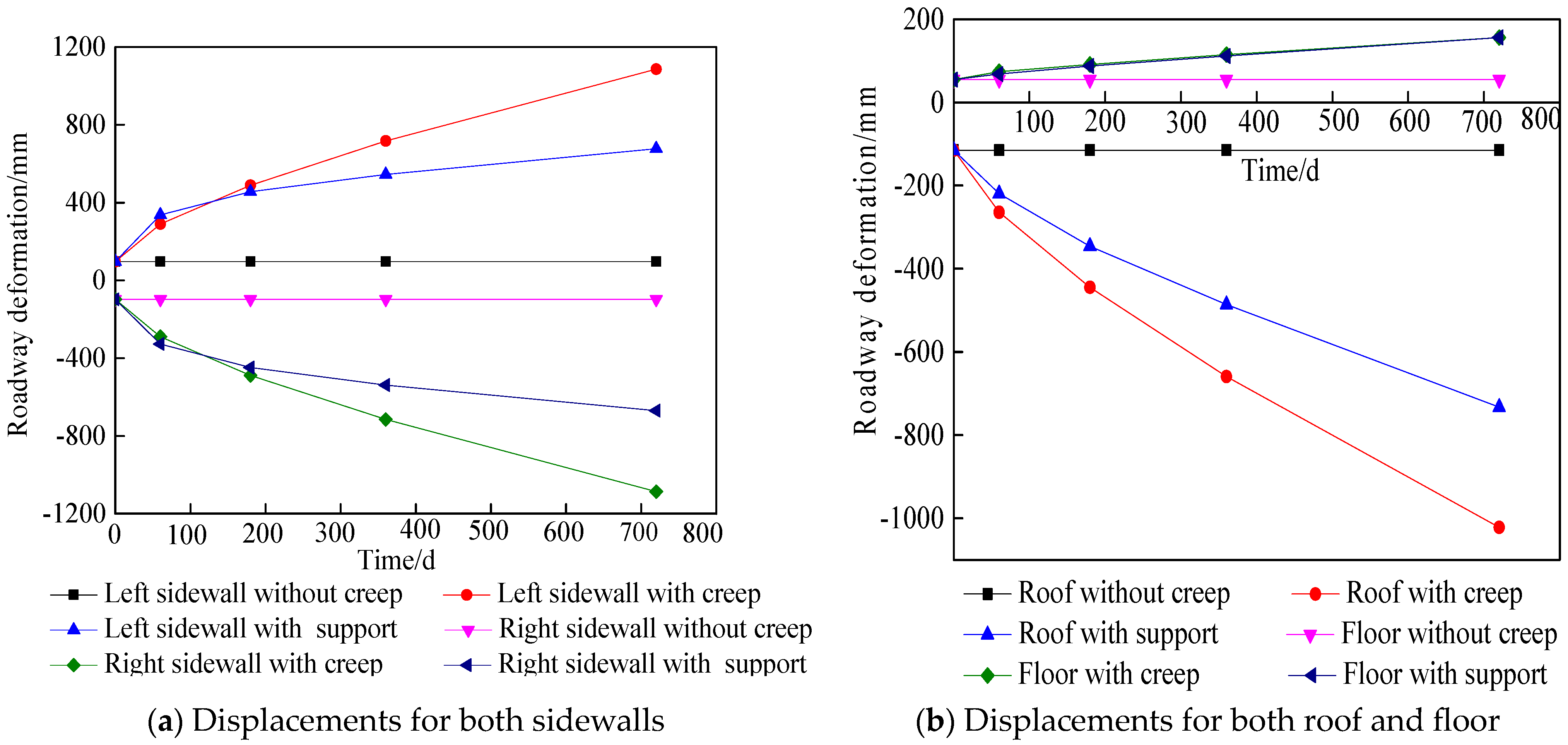

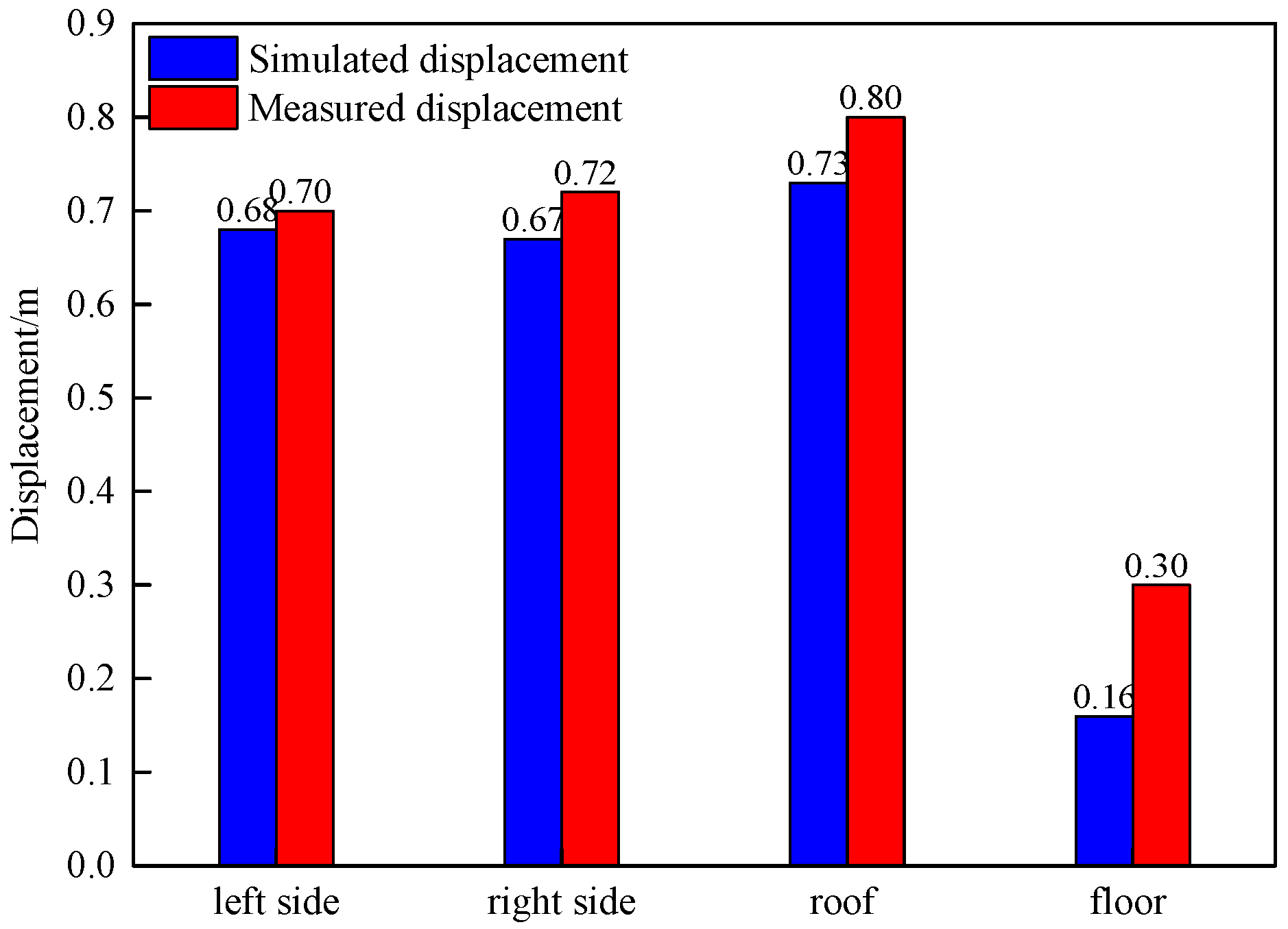
| Specimen (No.) | UCS (Mpa) | E (Gpa) | Density (g·cm−3) |
|---|---|---|---|
| A1 | 32.19 | 2.02 | 1.31 |
| A2 | 33.73 | 2.01 | 1.36 |
| A3 | 46.09 | 1.87 | 1.14 |
| B1 | 82.08 | 10.52 | 2.17 |
| B2 | 76.49 | 10.54 | 2.14 |
| B3 | 81.23 | 9.75 | 2.14 |
| Buried Depth (m) | Maximum Principal Stress (MPa) | Intermediate Principal Stress (Mpa) | Minimum Principal Stress (Mpa) | Burst Orientation (°) |
|---|---|---|---|---|
| 718 | 24.21 | 21.40 | 16.51 | 45 |
| 731 | 21.00 | 20.65 | 16.81 | 45 |
| Average | 22.60 | 21.00 | 16.66 | 45 |
| Rocktpe | Bulk (Gpa) | GK (Gpa) | GM (Gpa) | ηK (Gpa.h) | ηM (Gpa.h) | Cohesion (Mpa) | Internal Friction Angle (°) | Tensile Strength (Mpa) | Dilatancy Angle (°) |
|---|---|---|---|---|---|---|---|---|---|
| Siltstone | 2.02 | 132.6 | 6.1 | 937 | 23,079 | 1.60 | 26.1 | 1.75 | 11.6 |
| Sandy mudstone | 2.80 | 156.3 | 5.3 | 937 | 15,702 | 1.67 | 28.2 | 0.32 | 10.7 |
| 3-1 coal | 1.86 | 55.6 | 3.7 | 631 | 8703 | 1.28 | 21.8 | 0.15 | 15.3 |
| Sandy mudstone | 2.79 | 156.3 | 5.3 | 937 | 15,702 | 1.61 | 27.7 | 0.30 | 10.7 |
| Siltstone | 2.02 | 132.6 | 6.1 | 1331 | 23,079 | 1.60 | 26.1 | 1.75 | 11.6 |
| Density (kg m−3) | Elastic Modulus/Gpa | Poisson’s Ratio | Internal Friction Angle/(°) | Cohesion (Mpa) | Tensile Strength (Mpa) |
|---|---|---|---|---|---|
| 2350 | 25.0 | 0.18 | 35 | 7.5 | 4.0 |
| Rock Bolt | Length/m | E/Mpa | Tensile Strength/Mpa | Xcarea/m2 | Unit Length Cement Cohesion /N | Unit Length Cement Stiffness N/m | Anchor Solid Perimeter/m |
|---|---|---|---|---|---|---|---|
| Free section | 1 | 200 × 103 | 250 | 0.00038 | 1 | 1 | 0.0785 |
| Anchor section | 1.2 | 200 × 103 | 250 | 0.00038 | 1 × 106 | 1.75 × 107 | 0.0785 |
| Constitutive Model | Roadway Condition | Creep Time/d | Volume of Plastic Zone/m3 |
|---|---|---|---|
| No creep | No support | - | 4774.3 |
| 60 | 5761.3 | ||
| 180 | 5874.3 | ||
| No support | 360 | 6043.7 | |
| 720 | 6089.6 | ||
| 60 | 5508.2 | ||
| Creep | Oblique anchor spray | 180 | 5433.5 |
| 360 | 5262.0 | ||
| 720 | 5214.6 | ||
| 60 | 5516.2 | ||
| Straight anchor spray | 180 | 5433.5 | |
| 360 | 5252.5 | ||
| 720 | 5220.2 |
| Name | Preload (kN) | Breaking Load (kN) | Sidewall Support Density (m2/piece) | Roof Support Density (m2/piece) | Floor Support Density (m2/piece) |
|---|---|---|---|---|---|
| Anchor | 60 | 209.4 | 2.5 | 2.14 | 0.71 |
Disclaimer/Publisher’s Note: The statements, opinions and data contained in all publications are solely those of the individual author(s) and contributor(s) and not of MDPI and/or the editor(s). MDPI and/or the editor(s) disclaim responsibility for any injury to people or property resulting from any ideas, methods, instructions or products referred to in the content. |
© 2023 by the authors. Licensee MDPI, Basel, Switzerland. This article is an open access article distributed under the terms and conditions of the Creative Commons Attribution (CC BY) license (https://creativecommons.org/licenses/by/4.0/).
Share and Cite
Yang, Z.; Zhang, C.; Yang, D. Investigation of the Time-Dependent Stability of a Coal Roadway under the Deep High-Stress Condition Based on the Cvisc Creep Model. Sustainability 2023, 15, 12673. https://doi.org/10.3390/su151712673
Yang Z, Zhang C, Yang D. Investigation of the Time-Dependent Stability of a Coal Roadway under the Deep High-Stress Condition Based on the Cvisc Creep Model. Sustainability. 2023; 15(17):12673. https://doi.org/10.3390/su151712673
Chicago/Turabian StyleYang, Zhiliang, Cun Zhang, and Donghui Yang. 2023. "Investigation of the Time-Dependent Stability of a Coal Roadway under the Deep High-Stress Condition Based on the Cvisc Creep Model" Sustainability 15, no. 17: 12673. https://doi.org/10.3390/su151712673
APA StyleYang, Z., Zhang, C., & Yang, D. (2023). Investigation of the Time-Dependent Stability of a Coal Roadway under the Deep High-Stress Condition Based on the Cvisc Creep Model. Sustainability, 15(17), 12673. https://doi.org/10.3390/su151712673







